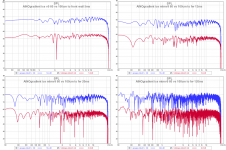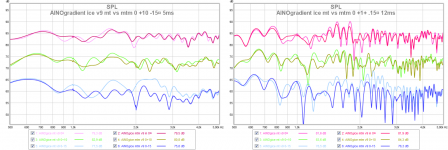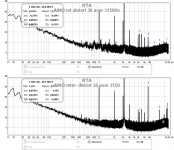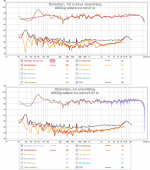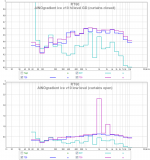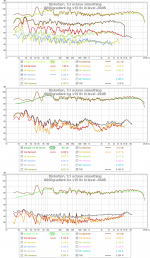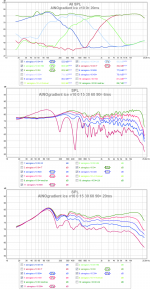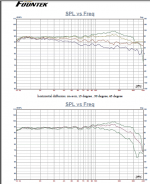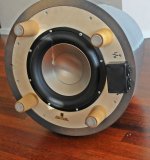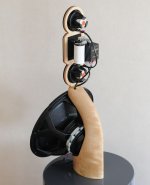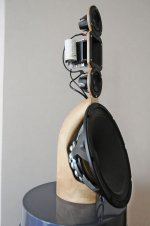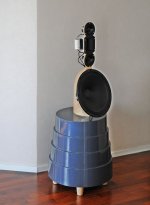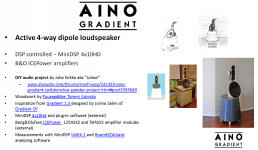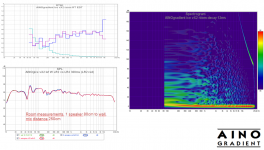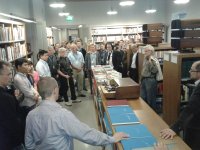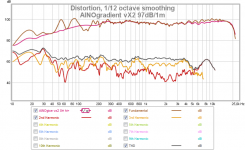My AINOs have omnipole bass (on the bottom of the box). Yes, it is very difficult to match it with lowmid dipole driver. Distance to boundaries affects low bass and induces frontwall reflections of the dipole backwave. Distance determines the Fq where summations and nulls come, we can see them in the graph (and easier with no smoothing). These are "heavier" than with boxed monopole speakers, but not as bad as with dipole basses
Widely apart, toed-in 30¤ and 1m from front wall is very good. I must also keep my position (head) at least the same 1m from the back-wall! This makes listening distance 1,5m It gives very good sound, but rest of the family doesn't like it . When I have privacy, I take a glass of wine with me to the sweet pot and enjoy
. When I have privacy, I take a glass of wine with me to the sweet pot and enjoy  Everyday listening must be done with speakers closer to the wall (60cm to dipoles) which is quite acceptable.
Everyday listening must be done with speakers closer to the wall (60cm to dipoles) which is quite acceptable.
Fortunately having a minidsp I can measure and tune it endlessly! MiniDSP 4x10HD box can have 4 preset configurations and I can change them from the panel wheel (no need to connect to computer and run setup program). Frontwall midrange reflections don't have to be eq'd but floor reflection and boundary boost are more constant and easier to eq. So far I haven't saved any roomeq configs, just learning... My indoors-made configs have some floor reflection correction, at my standard 150cm measuring distance Floor/Ceiling Reflection Calculator gives 279Hz (the low-mid driver at 60cm height)
Outdoor measurements are needed for basic driver eq and crossover configuration, but after that I make some indoors PEQ corrections to individual driver responses (based on several measurements), because I listen to these in a room, not outdoors!
Widely apart, toed-in 30¤ and 1m from front wall is very good. I must also keep my position (head) at least the same 1m from the back-wall! This makes listening distance 1,5m It gives very good sound, but rest of the family doesn't like it
 . When I have privacy, I take a glass of wine with me to the sweet pot and enjoy
. When I have privacy, I take a glass of wine with me to the sweet pot and enjoy  Everyday listening must be done with speakers closer to the wall (60cm to dipoles) which is quite acceptable.
Everyday listening must be done with speakers closer to the wall (60cm to dipoles) which is quite acceptable.Fortunately having a minidsp I can measure and tune it endlessly! MiniDSP 4x10HD box can have 4 preset configurations and I can change them from the panel wheel (no need to connect to computer and run setup program). Frontwall midrange reflections don't have to be eq'd but floor reflection and boundary boost are more constant and easier to eq. So far I haven't saved any roomeq configs, just learning... My indoors-made configs have some floor reflection correction, at my standard 150cm measuring distance Floor/Ceiling Reflection Calculator gives 279Hz (the low-mid driver at 60cm height)
Outdoor measurements are needed for basic driver eq and crossover configuration, but after that I make some indoors PEQ corrections to individual driver responses (based on several measurements), because I listen to these in a room, not outdoors!
Edited my measurements a little,
Distance to front wall
Mic position same, position of speaker moved 100cm vs 60cm to fornt wall. Horizontal angle a bit different but not significantly. In both measurements speaker is roughly at 30¤ angle to wall and 5¤ to mic (left speaker of stereo pair, mic at hot spot). behind the speaker is a window, which presents the WORST possible material.
My analysis. The effect on bass is not shown here but it is as loudness boost below 100Hz. The dipole radiation range of AINOs is 200-3000Hz, but I can't see any really big problems with these positions. Cancellations are more significant at 60cm but I can hardly hear any changes except low bass. Obviously nasties increase exponentially as distance gets even smaller.
60cm to front wall is the everyday position. For solo hi-fi sessions I just drag the top-gymnast 42kg AINOs to 100-110cm off the wall! Dipoles should always be toed-in at least 30¤!
Distance to front wall
Mic position same, position of speaker moved 100cm vs 60cm to fornt wall. Horizontal angle a bit different but not significantly. In both measurements speaker is roughly at 30¤ angle to wall and 5¤ to mic (left speaker of stereo pair, mic at hot spot). behind the speaker is a window, which presents the WORST possible material.
My analysis. The effect on bass is not shown here but it is as loudness boost below 100Hz. The dipole radiation range of AINOs is 200-3000Hz, but I can't see any really big problems with these positions. Cancellations are more significant at 60cm but I can hardly hear any changes except low bass. Obviously nasties increase exponentially as distance gets even smaller.
60cm to front wall is the everyday position. For solo hi-fi sessions I just drag the top-gymnast 42kg AINOs to 100-110cm off the wall! Dipoles should always be toed-in at least 30¤!
Attachments
Last edited:
MT vs MTM
Previous measurements edited and distortion test.
Previous vertical offset measurements get a closer look here, without smoothing but different IR windows (postprocessing in REW) Only the lower and upper mid(s) and tweeter playing in these measurements. XO frequencies are 1kHz LR4and 3.3kHz LR4.
Analysis: There is a difference but I can't say which is better overall. MT is better around 3kHz but MTM better around 1kHz.
Distortion with only a single or two upper mid playing, sine at 3150Hz. 36 samples. Please disregard 1kHz and its harmonics, they come from the defective sound card.
Analysis: M is significantly better, mainly because of high odd harmonics of MM
Note: I must perform more distortion measurements after changing the soundcard of UMIK-1. Distortion is a known problem in one batch of them and I got a replacement free. I just haven't changed it yet.
Previous measurements edited and distortion test.
Previous vertical offset measurements get a closer look here, without smoothing but different IR windows (postprocessing in REW) Only the lower and upper mid(s) and tweeter playing in these measurements. XO frequencies are 1kHz LR4and 3.3kHz LR4.
Analysis: There is a difference but I can't say which is better overall. MT is better around 3kHz but MTM better around 1kHz.
Distortion with only a single or two upper mid playing, sine at 3150Hz. 36 samples. Please disregard 1kHz and its harmonics, they come from the defective sound card.
Analysis: M is significantly better, mainly because of high odd harmonics of MM
Note: I must perform more distortion measurements after changing the soundcard of UMIK-1. Distortion is a known problem in one batch of them and I got a replacement free. I just haven't changed it yet.
Attachments
Last edited:
Some thinking processes and distortion tests have guided me to push a little more to the lower limits of NE95 pair and Fountek NeoCD3.5. Middle xo is LR2 again at 800Hz and upper LR4 at 2500hz. Obviously the slopes ease the drivers enogh, There doesn't seem to be a rise in distortion. LR2 between mids gives much better (even) wide angle response than LR4. Lowered tweeter xo should give better vertical off-axis, but I didn't measure it today.
Attachments show present v10 xo (W level to high) and distortion tests of the whole system playing. Individual drivers' distortion plot not shown here.
RT and EDT of my room - the effect of closing the light curtains kills the resonation at 2kHz.
It is now obvious to me that the 2kHz undulation I hear is very much this window resonation. These indoor tests don't tell the real behaviour of the speaker! Windows and furniture are rattling too! I haven't fixed the lower mid driver very well - it has vibrations around 100Hz. But overall the system looks solid. The weather doesn't permit outdoor measurements now.
I have also re-read the thread about dipole tweeters. There are problems. A B&G Neo 3 doesn't go much lower that CD3.5 and Neo8PDR has worse highs. A pair of 25mm tweeters is maybe worth testing... Then I could reduce mid-tweeter ctc from 95 to 80mm and use lower xo. But I very much like the sound now!
Attachments show present v10 xo (W level to high) and distortion tests of the whole system playing. Individual drivers' distortion plot not shown here.
RT and EDT of my room - the effect of closing the light curtains kills the resonation at 2kHz.
It is now obvious to me that the 2kHz undulation I hear is very much this window resonation. These indoor tests don't tell the real behaviour of the speaker! Windows and furniture are rattling too! I haven't fixed the lower mid driver very well - it has vibrations around 100Hz. But overall the system looks solid. The weather doesn't permit outdoor measurements now.
I have also re-read the thread about dipole tweeters. There are problems. A B&G Neo 3 doesn't go much lower that CD3.5 and Neo8PDR has worse highs. A pair of 25mm tweeters is maybe worth testing... Then I could reduce mid-tweeter ctc from 95 to 80mm and use lower xo. But I very much like the sound now!
Attachments
Last edited:
Some thinking processes and distortion tests have guided me to push a little more to the lower limits of NE95 pair and Fountek NeoCD3.5. Middle xo is LR2 again at 800Hz and upper LR4 at 2500hz. Obviously the slopes ease the drivers enogh, There doesn't seem to be a rise in distortion. LR2 between mids gives much better (even) wide angle response than LR4. Lowered tweeter xo should give better vertical off-axis, but I didn't measure it today.
Attachments show present v10 xo (W level to high) and distortion tests of the whole system playing. Individual drivers' distortion plot not shown here.
RT and EDT of my room - the effect of closing the light curtains kills the resonation at 2kHz.
It is now obvious to me that the 2kHz undulation I hear is very much this window resonation. These indoor tests don't tell the real behaviour of the speaker! Windows and furniture are rattling too! I haven't fixed the lower mid driver very well - it has vibrations around 100Hz. But overall the system looks solid. The weather doesn't permit outdoor measurements now.
I have also re-read the thread about dipole tweeters. There are problems. A B&G Neo 3 doesn't go much lower that CD3.5 and Neo8PDR has worse highs. A pair of 25mm tweeters is maybe worth testing... Then I could reduce mid-tweeter ctc from 95 to 80mm and use lower xo. But I very much like the sound now!
By lowering the crossover point you have better matched the CtC distance of the NE95's improving the acoustic phase angle. LR4 would may have attenuated the off axis too much. Have you nulled the ribbons impedance peak? Also on the NE95's and the low mid? Would help to reduce IMD in their pass bands.
Have you nulled the ribbons impedance peak? Also on the NE95's and the low mid? Would help to reduce IMD in their pass bands.
No passive parts except the protective 6.8uF cap in series with the tweeter. Impedance peaks are way out of passbands (except the woofer)!
Beyma 12" peak at 40Hz (xo 150 LR4)
Peerless/Vifa NE95 peak at 95Hz (xo 800 LR2)
Fountek 3.5H peak around 800Hz? (xo 2500 LR4)
I haven't done similar distortion test of any other speaker so far - I must get some control samples at same level! SPL level is not calibrated except the UMIK-1 cal file. Must be checked with another meter. The sweep sounded horrible and I just can't listen to music at same level (-20dB in receiver/preamp) for a long time.
Thank you Greebster for advice and PMs!
Fountek datasheet says that Neo3.5H has an impedance flattening circuit built-in
http://www.fountek.net/uploadfile/1011/25100645.PDF
Ih has a special off-axis that made me to choose it!
http://www.fountek.net/uploadfile/1011/25100645.PDF
Ih has a special off-axis that made me to choose it!
Attachments
I have prepared a 15-page powerpoint presentation of this project. If someone is interested, please send me PM and tell your email adress, and I will send a pdf copy to you!
About bass performance, I took some nearfield measurements and here you can see the options of LR2 and LR4 at 130Hz. -6dB in nearfiel is at 25Hz. 300ms room response start at 15Hz if we believe UMIK and REW! The bass channel of minidsp has Linkwitz Transform type peq at 40Hz, Q=1, -6dB (to avoid digital clipping) Driver is SEAS L26ROY in 25 liter sealed cabinet.
About bass performance, I took some nearfield measurements and here you can see the options of LR2 and LR4 at 130Hz. -6dB in nearfiel is at 25Hz. 300ms room response start at 15Hz if we believe UMIK and REW! The bass channel of minidsp has Linkwitz Transform type peq at 40Hz, Q=1, -6dB (to avoid digital clipping) Driver is SEAS L26ROY in 25 liter sealed cabinet.
Attachments
Last edited:
Greetings from the 51st AES Conference!
I had the pleasure of chatting with Mrs and Mr Linkwitz an I presented him the AINOgradient project paper. SL encouraged me to try dipole bass too, hmm..
Dr.Klippel was there among others, a nice day! Chatted with John from Bose Corp. and some Finnish students who are making 3D directivity and room reflection studies. Sorry i skipped the sauna but I had to drive back home and go to work at 8 am.
I had the pleasure of chatting with Mrs and Mr Linkwitz an I presented him the AINOgradient project paper. SL encouraged me to try dipole bass too, hmm..
Dr.Klippel was there among others, a nice day! Chatted with John from Bose Corp. and some Finnish students who are making 3D directivity and room reflection studies. Sorry i skipped the sauna but I had to drive back home and go to work at 8 am.
Attachments
Greetings from the 51st AES Conference!
I had the pleasure of chatting with Mrs and Mr Linkwitz an I presented him the AINOgradient project paper. SL encouraged me to try dipole bass too, hmm..
Dr.Klippel was there among others, a nice day! Chatted with John from Bose Corp. and some Finnish students who are making 3D directivity and room reflection studies. Sorry i skipped the sauna but I had to drive back home and go to work at 8 am.
Are you sure you want to open that can of worms?
Are you sure you want to open that can of worms?
..says a man who's not afraid of alligators!
Juha,
Your Aino is a beautiful artistic statement piece (suits a Fin).
But from an audio point of view, it would be better off if you kept the sub and dipole as separate units (just my opinion).
This would allow you to better place the subs in the room.
Also you would be more free to experiment with the dipole design.
For example, a swinging dipole design might sound better.
And I agree, largeish nude drivers ring a lot when driven below 200-300 Hz.
After hearing your experience, I am worried about my CD3.5H application (regarding ctc issues). I was thinking of crossing B&G Neo8S to CD3.5H around 3500-5000Hz in a vertical set-up. Now I am thinking, my options are realisticaly 2500 or 10000 Hz. Perhaps I should move to a horizontal placement (side-by-side). My baffle is very wide regardless and the Fountek driver is horned (won't see the baffle or its edges above 5000Hz anyway)
Your Aino is a beautiful artistic statement piece (suits a Fin).
But from an audio point of view, it would be better off if you kept the sub and dipole as separate units (just my opinion).
This would allow you to better place the subs in the room.
Also you would be more free to experiment with the dipole design.
For example, a swinging dipole design might sound better.
And I agree, largeish nude drivers ring a lot when driven below 200-300 Hz.
After hearing your experience, I am worried about my CD3.5H application (regarding ctc issues). I was thinking of crossing B&G Neo8S to CD3.5H around 3500-5000Hz in a vertical set-up. Now I am thinking, my options are realisticaly 2500 or 10000 Hz. Perhaps I should move to a horizontal placement (side-by-side). My baffle is very wide regardless and the Fountek driver is horned (won't see the baffle or its edges above 5000Hz anyway)
zmyrna, I went back to lower xo and there are no problems with distortion, when crossing at 2500Hz LR4. The horn obviously helps a lot in comparison to 3.0. Parallel mt is no-no - strong unsymmetrical (L to R) lobing. T/MM (a triangle) might be worth doing?
Aino at 97dB/1m distortion, measured indoors at 1m distance. T xo 2500Hz LR4
Aino at 97dB/1m distortion, measured indoors at 1m distance. T xo 2500Hz LR4
Attachments
Due to the 3.5's height and the narrowness of the BG8's this would be difficult to pull off. BUT, if we were to lay the Neo8's sideways with the CD3.5 between this may work when crossed <2.5k. Perhaps even better would be to have two Neo8's horizontal above and below.Juha,
Your Aino is a beautiful artistic statement piece (suits a Fin).
But from an audio point of view, it would be better off if you kept the sub and dipole as separate units (just my opinion).
This would allow you to better place the subs in the room.
Also you would be more free to experiment with the dipole design.
For example, a swinging dipole design might sound better.
And I agree, largeish nude drivers ring a lot when driven below 200-300 Hz.
After hearing your experience, I am worried about my CD3.5H application (regarding ctc issues). I was thinking of crossing B&G Neo8S to CD3.5H around 3500-5000Hz in a vertical set-up. Now I am thinking, my options are realisticaly 2500 or 10000 Hz. Perhaps I should move to a horizontal placement (side-by-side). My baffle is very wide regardless and the Fountek driver is horned (won't see the baffle or its edges above 5000Hz anyway)
Due to the 3.5's height and the narrowness of the BG8's this would be difficult to pull off. BUT, if we were to lay the Neo8's sideways with the CD3.5 between this may work when crossed <2.5k. Perhaps even better would be to have two Neo8's horizontal above and below.
My side-by-side proposition is very similar: instead of stacking vertically, everything is stacked horizontally.
Juha, the lobing would be there no matter. Dose it really matter if it is horizontal or vertical?
M and T side by side is terrible, unless xo is below say 1kHz. Side by side mtm is acceptable perhaps xo around 1,7kHz. Mtm has the benefit of creating symmetrical lobing instead of the unsymmetrical lobing of mt. The problem with mtm is comb filtering which is actually just distributed lobing. These can be seen with Xdir simulations easily.
It is generally accepted that with home stereo and multichannel systems, we must avoid/minimize horizontal lobing but we can live with vertical lobing. Because usually we have listeners spread horizontally side by side, not stacked vertically! Sometimes vertical nulling is intentionally directed downwards 30-45¤ to minimize floor reflections (like AINO).
In monitoring studios we can see lots of speakers placed in a wrong way. Also many big multiway monitors have not ideal driver placements in the baffle. But that is a studio! Obviously the sound engineer has measured and calibrated straight and room response with pink noise/rta or some more sophisticated system. But at home we are in a more challenging environment.
Controlled/constant directivity of a loudspeaker helps the user to achieve good/best possible result as easily as possible in many different rooms, without nitpicking with speaker placement and room treatment. In an anechoid chamber or an excellently treated room, almost any speaker with good on-axis sounds good. Users of fullrange or large planar speakers must be very accurate with placement.
I believe that the room and speaker choice must match. Also placement of speakers and furniture give outlines and limits of what can be achieved. My living room and my "home theater" room are very different, have very different AV systems and have a very different sound and I like them both!
SL said to me that a good speaker is essential. The brain will get adapted to a room, it's reverberations and modes. I agree and disagree, based on my limited experience. Unless we are listening nearfiel (less than 1,5m) I can always hear the room effects. I will get adatped and the sound may be very good, but there is a remarkable difference.
About bass, I am very pleased to have two woofers covering 20-150Hz. My previous speakers were mostly used with one subwoofer xo 80Hz. Two low-going woofers are better in my room! The ideal system, I believe, would be a multisub ala Geddes for below 80Hz, but that is unrealistic for me in my living room. In my HT I have two subs, three would be better but I don't have a place for #3 now.
Speakers and a setup at home is ALWAYS a compromise!
It is generally accepted that with home stereo and multichannel systems, we must avoid/minimize horizontal lobing but we can live with vertical lobing. Because usually we have listeners spread horizontally side by side, not stacked vertically! Sometimes vertical nulling is intentionally directed downwards 30-45¤ to minimize floor reflections (like AINO).
In monitoring studios we can see lots of speakers placed in a wrong way. Also many big multiway monitors have not ideal driver placements in the baffle. But that is a studio! Obviously the sound engineer has measured and calibrated straight and room response with pink noise/rta or some more sophisticated system. But at home we are in a more challenging environment.
Controlled/constant directivity of a loudspeaker helps the user to achieve good/best possible result as easily as possible in many different rooms, without nitpicking with speaker placement and room treatment. In an anechoid chamber or an excellently treated room, almost any speaker with good on-axis sounds good. Users of fullrange or large planar speakers must be very accurate with placement.
I believe that the room and speaker choice must match. Also placement of speakers and furniture give outlines and limits of what can be achieved. My living room and my "home theater" room are very different, have very different AV systems and have a very different sound and I like them both!
SL said to me that a good speaker is essential. The brain will get adapted to a room, it's reverberations and modes. I agree and disagree, based on my limited experience. Unless we are listening nearfiel (less than 1,5m) I can always hear the room effects. I will get adatped and the sound may be very good, but there is a remarkable difference.
About bass, I am very pleased to have two woofers covering 20-150Hz. My previous speakers were mostly used with one subwoofer xo 80Hz. Two low-going woofers are better in my room! The ideal system, I believe, would be a multisub ala Geddes for below 80Hz, but that is unrealistic for me in my living room. In my HT I have two subs, three would be better but I don't have a place for #3 now.
Speakers and a setup at home is ALWAYS a compromise!
- Home
- Loudspeakers
- Multi-Way
- Aino gradient - a collaborative speaker project
